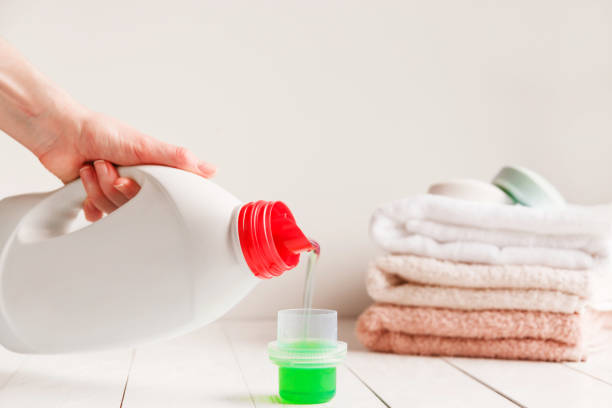Project Report For Liquid Detergent Manufacturing
Introduction
Project report for Liquid Detergent Manufacturing is as follows.
A detergent is a surfactant mixture that has cleaning properties in dilute solutions. These substances are typically alkyl benzene sulfonates, a family of compounds similar to soap but more soluble in hard water because the polar sulfonate (of detergents) is less likely to bind to calcium and other ions found in hard water than the polar carboxylate (of soap).
Liquid Detergent instantly liquefies when it comes into contact with water. Contrarily, powder detergent takes longer to liquefy; for optimal results, properly mix powder detergent before adding water. We’re sure you’ve seen the advertisements where the brand spokespeople demonstrate how to add two spoons of detergent to a pail of water and swirl the mixture. liquid detergent can now be used by simply adding the solution to your washing machine’s cap.
Powder detergent works best when washing clothes by hand, while liquid detergent is preferred when using a washing machine or fully automatic washer since it dissolves more quickly and leaves no white residue on the fabric. Additionally, this white residue can injure you in a variety of ways and irritate your skin.
Bleach can leave an unattractive mark and harm your delicate materials. Despite the fact that liquid detergent is bleach-free, it still works well with silk and chiffon fabrics. However, powder detergent includes a bleaching agent that might lighten the color of your clothing.

One of the inherent advantages of liquid detergent over powder is that its packaging makes it easier to use and store, from the built-in measuring-cup cap to the easy-to-carry integrated handle. However, the advantages of liquid detergent extend beyond its convenience.
One significant advantage of liquid detergent is that it can be applied directly to tough stains on clothes as a pre-treatment. Powder detergent can also be used as a pre-treatment, but it must be mixed with water to form a paste before being applied directly to clothing. You’ll never have to worry about cleaning undissolved powder because liquid detergent is already dissolved.
Project Report Sample Of Liquid
Detergent Manufacturing
Get Completely Custom Bankable Project Report
LIQUID DETERGENTS MANUFACTURING PROCESS
Formulation: The first step in the manufacture of liquid detergent is to formulate the product. The formulation process involves selecting the raw materials and determining the proportions in which they will be used. The raw materials commonly used in liquid detergent formulation include surfactants, builders, enzymes, and preservatives.
Mixing: Once the formulation has been determined, the raw materials are mixed together in a large mixing tank. The mixing process is carried out under controlled conditions to ensure that the ingredients are thoroughly mixed.
Heating: After the mixing process, the liquid detergent mixture is heated to a temperature of about 60°C. This temperature helps to dissolve the ingredients and also ensures that the detergent is free from any microbial contamination.
Cooling: After the heating process, the liquid detergent is cooled to room temperature. This helps to ensure that the detergent is stable and will not degrade over time.
Homogenization: Once the detergent has cooled, it is homogenized to ensure that it is a uniform mixture. Homogenization involves the use of high-pressure pumps that force the liquid detergent through a series of small openings, which break up any remaining particles and ensure that the detergent is smooth and consistent.
Packaging: After homogenization, the liquid detergent is packaged in bottles, pouches, or other containers. The packaging process is carried out under controlled conditions to ensure that the detergent is free from any contaminants.
Quality control: The final step in the manufacture of liquid detergent is quality control. This involves testing the detergent to ensure that it meets the desired specifications, such as pH, viscosity, and foaming properties. Any defects or issues are identified and corrected before the detergent is released for sale.
Technology advancement has led to the development of modern liquid detergents, which is expected to drive market growth for liquid detergents in the following years. The usage of appliances like washing machines and dishwashers is projected to rise in both developing and developed countries, supporting the market for liquid detergents.
Market Potential Liquid Detergent Manufacturing
The market for liquid detergents was valued at $27,405 million in 2017 and is anticipated to increase to $40,482 million by 2025, with a compound annual growth rate (CAGR) of 5.2% between 2018 and 2025.
Expenses

Product Cost Breakup

Reveneue Vs Expenses

Market Trend

The research divides the global market for liquid detergent into online sales channels, supermarkets and hypermarkets, departmental and convenience stores, and independent grocery stores based on the sales channel. Due to an increase in grocery delivery companies, the online sales channels segment is predicted to rise quickly during the forecast period. Nevertheless, the sector of supermarkets and hypermarkets will continue to hold a disproportionate amount of the liquid detergent market share during the projection period.
The liquid detergent market is examined in each of the following regions: North America, Europe, Asia-Pacific, and LAMEA. For liquid detergent, North America is a mature, uniform market with significant product consumption. Due to an increase in the adoption of automated dishwashers throughout the continent, the European market is expanding significantly.
Due to rising household income, rapid urbanization, an increase in the population of the middle class, easy access to goods due to the expansion of retail channels, and an increase in washing machine penetration, the Asia-Pacific liquid detergent market is expected to experience rapid growth in the near future.

